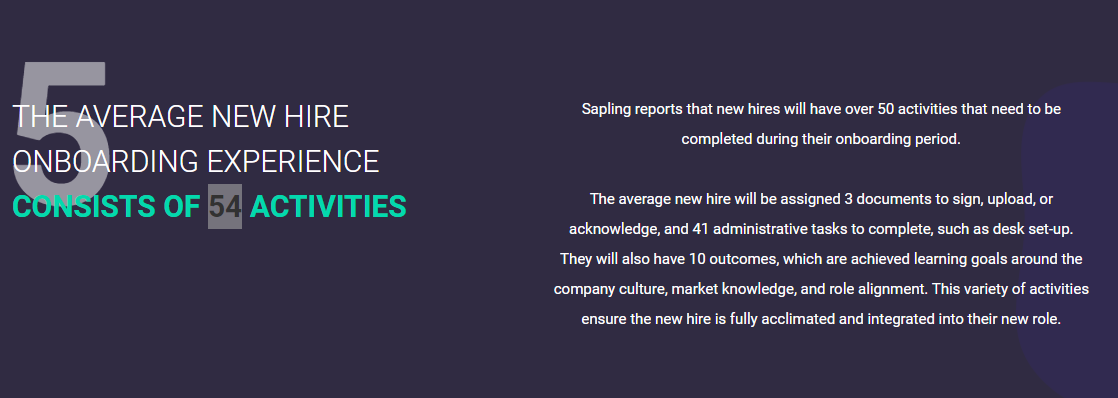Since the outbreak of the pandemic, businesses have been forced to go fully or partially remote.
From face-to-face meetings to online video calls, a lot has changed in how companies operate today.
Although this new work setup has brought with it multiple benefits – higher productivity and lower absenteeism, it has also thrown daunting challenges, remote onboarding being one of them.
While in the pre-pandemic era, new employees could shadow their seniors and build bonds over coffee breaks, the virtual world works differently. Without the warmth of in-person interactions, employees are likely to feel out of place and unwelcomed in a new workplace.
So, how do you conquer these challenges and create a remote onboarding experience that is as warm, connected, and supportive as offline onboarding?
From setting clear expectations from the get-go to creating an employee handbook, we have compiled a list of 9 astounding tips for successful remote onboarding. But before we explore them, let’s clear our basics about remote onboarding.
Let’s go.
What is Remote Employee Onboarding?
Remote employee onboarding is a process where new employees are welcomed, trained, and brought up to speed with their new roles and responsibilities. All of this happens in a virtual environment with the help of video calls and other employee onboarding software.
Just like offline onboarding, the aim of virtual onboarding is to give employees a well-rounded view of your company’s culture, processes, and policies and help them embark on the new journey with confidence.
A smooth remote onboarding builds a rock-solid foundation for new employees by giving a clear picture of what the company expects from them and what they can expect in return. This sets them in the right direction and helps them contribute meaningfully to the company’s growth.
Since remote onboarding is carried out via online platforms, it’s crucial to conduct both formal and informal meetings regularly. While such meetings cannot replace the informal coffee breaks and fun-filled in-person training sessions, they can make employees feel less isolated while working remotely.
What is the Difference Between Remote Onboarding & Orientation?
Onboarding and orientation – both these terms are often used interchangeably because of the fact that both these processes work with a single goal – turn new hires into productive resources. The only difference lies in their duration and implementation.
Orientation is a one-time process that happens right after an employee joins. On the other hand, onboarding is a continuous process involving a series of events that last for three months and sometimes go on until a year.
Employee orientation involves a quick welcome and brief introduction of what you do and how you work. On the other hand, onboarding is a broad term that includes but is not limited to orientation.
While orientation is usually for a week or so, onboarding is a thorough process involving regular meetings where new hires get to interact with their colleagues and understand the specifics of their roles.
9 Golden Tips to Set Your Remote Employees for Success From Day 1
The remote setup doesn’t offer employees the opportunity to organically integrate with your work culture. That’s precisely why remote onboarding has to be carefully executed for long-term employee happiness and success.
Here are 9 astounding remote onboarding tips to make the journey of new employees less bumpy and more fulfilling.
1. Give New Employees a Warm Welcome
Real onboarding starts before an employee officially joins your organization. You can get the ball rolling well in advance and set the right tone for the employees’ journey by surprising them with a welcome package.
Free goodies and personalized employees gifts, along with a letter from your CEO, make for a perfect recipe to double up the excitement level of new hires.
You can send this welcome kit right after rolling out the offer letter and receiving acceptance from the candidate. This is a great way to instill a sense of connection in candidates even before they meet the team they will be working with.
While such gestures ease up the nerves of new candidates, they also put your company in a good light. Candidates would love to brag about their experience on social media, which will get people talking not just about your brand but also about your amazing onboarding system.
FREE. All Features. FOREVER!
Try our Forever FREE account with all premium features!
2. Make the First Day Memorable
Do you remember your first day in a new office?
Unfamiliar surroundings and unknown people. It would have been overwhelming, right?
This used to happen even when everything was normal and remote working wasn’t so widespread. Imagine how dreary the first days can be for employees joining remotely!
Now that you know the jitters that the first day brings, you can bring in a system that makes new hires feel more welcomed and comfortable in the remote setup.
Keep the first day light by letting new employees watch the videos of your good old office days. Surprise them with a warm welcome email, video messages from their team members, and little notes from people they will be working with.
You can also host a virtual lunch to break the ice, share some laughs, and make new hires feel at ease on their first day of joining.
3. Assign a Buddy
Ask any HR professional about the best tips for remote onboarding, and they will surely stress on the importance of adopting a Buddy system.
It is natural for new hires to feel isolated during their initial days, especially in a remote work environment. It will not take much time for this feeling of isolation to aggravate, if not handled on time.
A recent survey conducted on over 2000 remotely working Americans revealed that 7 out of 10 employees still feel isolated in a virtual work environment. In fact, only a meager 4% of new employees feel that remote onboarding is satisfactory, while others have no clue how to stay connected with their colleagues.
Clearly, new hires need a friend and mentor to help them navigate their struggles of remote working.
You can assign them a buddy who is like the go-to person that answers all their questions and demystifies the rules followed in the team. The buddy system ensures that new employees always have someone to guide them every time they get stuck at work or simply need a friend to lean on.
When employees feel at peace and included in the team, it will also reflect their performance.
4. Set Up Virtual Meets & Greets
One of the most daunting remote onboarding challenges is that despite multiple measures, employees can end up feeling isolated and confused on most days.
So, what can be the solution to this persistent problem?
Virtual meets and greets work wonderfully in a remote work environment. Especially during onboarding, short virtual meetings give new employees the opportunity to know their colleagues and understand how their team operates.
Such meetings don’t have to be all work and no fun. You can always mix informal chit-chats and fun virtual ice breakers in the formal meetings to make work less overwhelming for new hires.
Onboarding usually lasts for a minimum of three months, which is a really long time. So, ensure that such meetings are not robotic. Rather, they should be fun, engaging, and work-oriented in equal parts.
In the initial days of joining, you can also schedule one-on-one meetings with team leaders and department heads. Such close interactions will build trust in new employees and help them sink into your work culture faster.
5. Provide Self-Learning Tools
Just like customers, employees, too, are big fans of self-service. It lets them learn at their own convenient pace and keeps them from badgering HR, colleagues, and seniors for trivial matters.
“The days of employees calling or e-mailing the HR service center for answers to routine questions are almost over,” Jeanne Meister, Founding Partner, Future Workplace. – Source
With a system of self-learning in place, new employees always have a trusted resource to guide them in situations where they are confused or need a helping hand.
For example, if there is a company policy or a leave application process that new employees need guidance on, they can refer to your employee handbook or internal knowledge base to get the help they need.
An employee handbook acts as a one-stop platform, providing new employees quick access to crucial information on your policies, products, vision, mission, culture, and a lot more.
To help employees make the most of this self-help system, you can integrate it with a communication platform like Slack. This way employees will get instant updates on any changes or additions to your employee handbook, right in their Slack dashboard.
While this makes learning easier, it also helps new employees stay productive right from day one.
Here’s a short video on how you can create an employee handbook with employee handbook software for your new hires.
FREE. All Features. FOREVER!
Try our Forever FREE account with all premium features!
6. Give a Virtual Spin to Fun Activities
Remember the good old office days? It was easier to make connections in those days, filled with fun, laughter, and candid conversations over coffee, long walks, and team lunches.
While the people are the same, the setting is different now. But that shouldn’t stop you from creating a welcoming and fun-filled workplace; new hires would love to be a part of.
Think of all the fun activities employees happily participated in during office days and give them a virtual spin. For example, you can have coffee or tea sessions online, brain-twisting online games where teams work together to win the hamper are some great options.
You can also have games like Food Trivia, organize fitness challenges, or conduct activities asking employees to share glimpses of their work from home setups.
The remote onboarding culture doesn’t have to be siloed. Instead, it can be equally, if not more, engaging and fun as the long-gone work from office days. With these fun activities, new hires are likely to feel at ease and build strong connections with people across teams.
7. Keep Clear Expectations From the Get-Go
New hires should have complete clarity on what your organization expects from them, so they can start on the right foot from day one.
In a virtual setup where the first few days are filled with anticipation and uncertainty around what to do, what to expect, and who to seek help from, setting expectations is all the more important.
Explain the roles and responsibilities and show how they are aligned with the company’s overall success. Ask the team leaders to give presentations on the company goals and what contributions are expected from the new employee. This level of clarity is crucial to help them prioritize work and achieve quick wins in the first few months.
As the role of new hires gets complex with more responsibilities coming their way, they will be able to easily adapt to the changes. All thanks to the strong foundation built in the initial days. As productivity is one of the major remote onboarding challenges, a structured onboarding program with goals and expectations clearly laid out can be a huge help. It can set new hires to a good start from the start and boost their productivity by a whopping 70%.
8. Conduct Online Training Sessions
Creating internal documentation or an employee handbook is undoubtedly a great way to ramp up employee onboarding. But you can also take the help of online training sessions to fast track the learning process.
These training sessions can be around the new roles an employee is hired for, the products and services they will be working on, and the standard operating procedures your company follows.
The IT SPOC (Single point of contact) can take a session on password management, device security, and other tools your company uses. Department heads can take sessions on the long-term and short-term goals new hires are expected to accomplish in the process the team follows to complete tasks and get approvals.
Similarly, the HR team can take sessions on basic HR processes that employees should be able to take care of on their own.
Have QnA rounds after every session and give new hires an opportunity to ask questions and get all their doubts clarified. Besides, you can also give them access to your training courses for self-paced anytime, anywhere learning.
What more?
Weekly one-on-one sessions with new hires is another way you can keep them abreast of their tasks, discuss potential issues, and help them settle into their new roles.
9. Personalize the Remote Onboarding Process
While some parts of the onboarding process, such as hosting the virtual lunch and training on SOPs, are similar, others should be tailored to the specific needs of new hires. According to research, the onboarding process for an average new employee consists of 54 activities. Some of these activities, especially the administrative tasks, can eat up the precious time of new employees, who should rather be focusing on work that really matters.
Therefore, there should be a customized learning path that connects new hires with the right programs they need to grow while eliminating all unnecessary activities.
For a well-tailored onboarding process, you first need to analyze the overall skill and knowledge level of the new hire with the help of online tests and by making quizzes.
Use this data to refine your remote onboarding program and make employees feel personally engaged in the process. Include specific online courses and training sessions in the process to impart the right skills to new hires and bring them at par with what the role really demands.
For example, for a person who has joined your content marketing team, the courses can be around how to write killer content and how to optimize the content for search engines.
On the other hand, for an associate joining your HR team, the onboarding process can have training courses on how to interview candidates and how to foster discipline in the workplace.
Here is a quick video on how you can create such courses.
FREE. All Features. FOREVER!
Try our Forever FREE account with all premium features!
Remote Onboarding Process Checklist
The process of onboarding remote employees during COVID can be tedious. Sometimes, limited real-time, in-person communication makes even the simplest of tasks energy-draining. Here is a quick remote onboarding checklist to kick off the process:
- Send them a welcome kit including a little manual highlighting your company rituals, vision, and mission.
- Arrange one-on-one meetings with team leaders, department heads, and colleagues.
- Host an introductory virtual lunch to break the ice and ease up the nerves for new hires.
- Provide them access to your employee portal and help them become self-sufficient.
- Use knowledge base software to Create internal documentation highlighting the new member’s KRAs, company policies, and culture.
- Familiarize new employees with the tools you frequently use for remote working. For example, tools for tracking work hours, project management, expense reporting, and more. Check in with your new employees once every week to identify any issues they are facing at work.
- Prepare a calendar for the first few weeks, highlighting the training sessions and meetings to be attended.
- Take employee feedback regularly and incorporate it into your onboarding process. Don’t forget to celebrate a new hire’s wins once the onboarding process is about to end.
Most importantly, do everything possible to let new employees know that they are one of you!
Give New Employees Every Reason to Stick With You
Remote onboarding during COVID isn’t an easy feat to achieve. Since the remote context misses out on moments of comfort like bonding over lunch and building lasting relationships in the office cubicles, you’ve to put in extra effort for virtual onboarding to be successful.
First of all, make employees feel welcome. Take steps to reduce the first-day nerves by conducting video meetings over Zoom, taking them on a virtual tour of your office, and creating personalized onboarding experiences. Set clear expectations from the start and organize fun activities to help employees give their best at work while also having fun at the same time.
Craft an onboarding program that builds a strong foundation for the new hires’ continued growth and development that stretches beyond the first 30 or 90 days.
Do everything in your power to make employees feel at ease and be their confident, real selves right from the start!
 Tips
Tips
We’d love to hear your tips & suggestions on this article!
FREE. All Features. FOREVER!
Try our Forever FREE account with all premium features!


 We'd love your feedback!
We'd love your feedback! Thanks for your feedback!
Thanks for your feedback!







